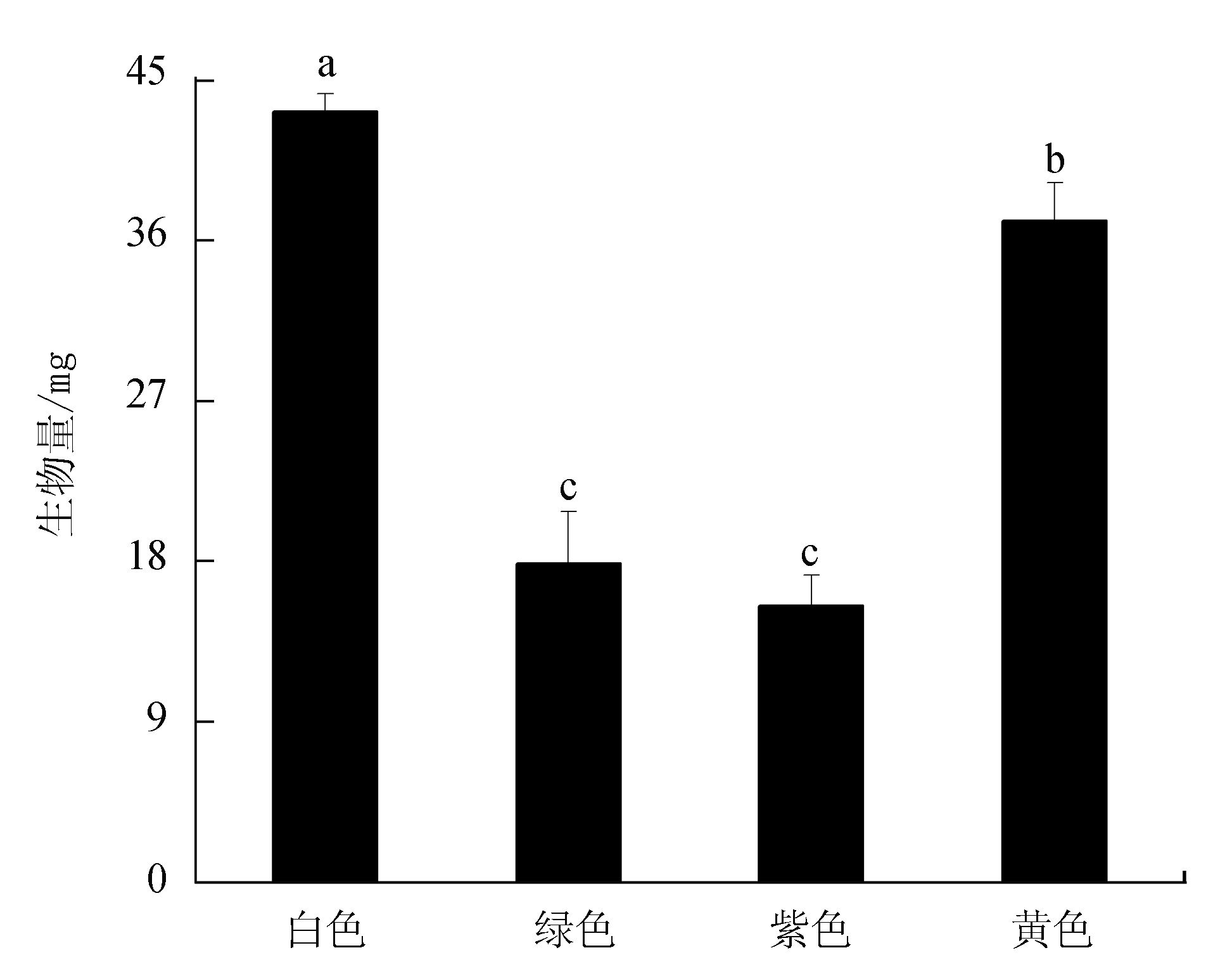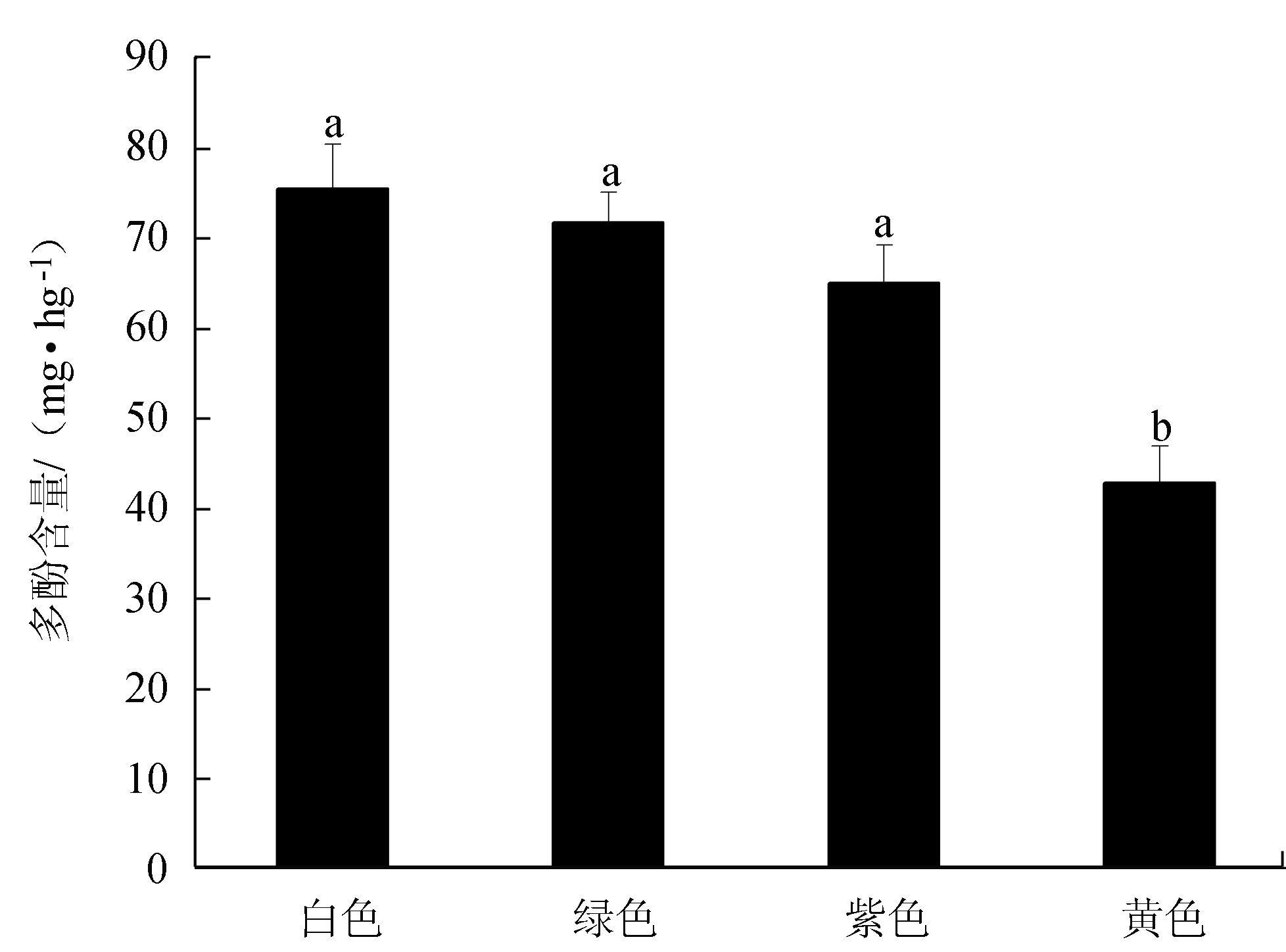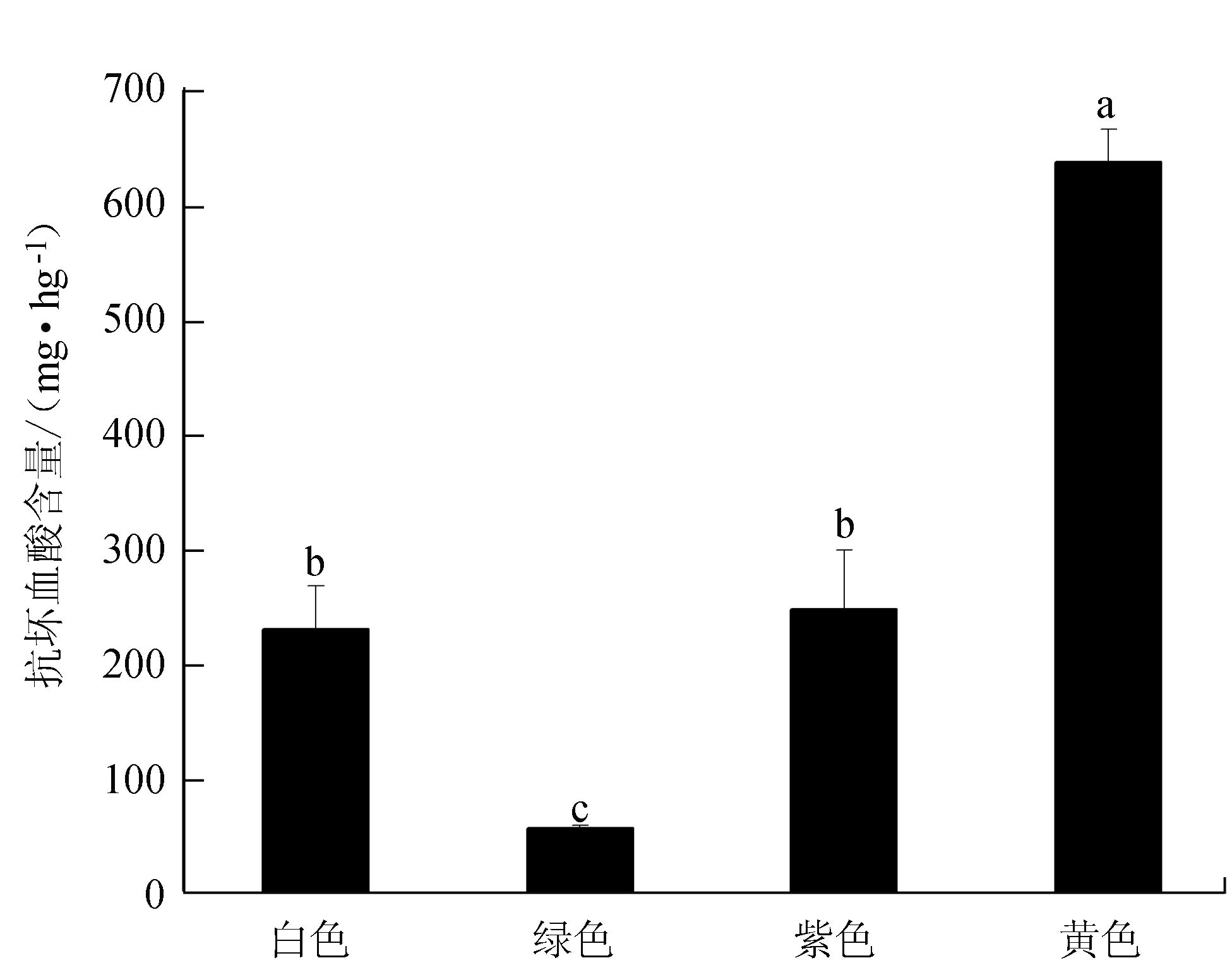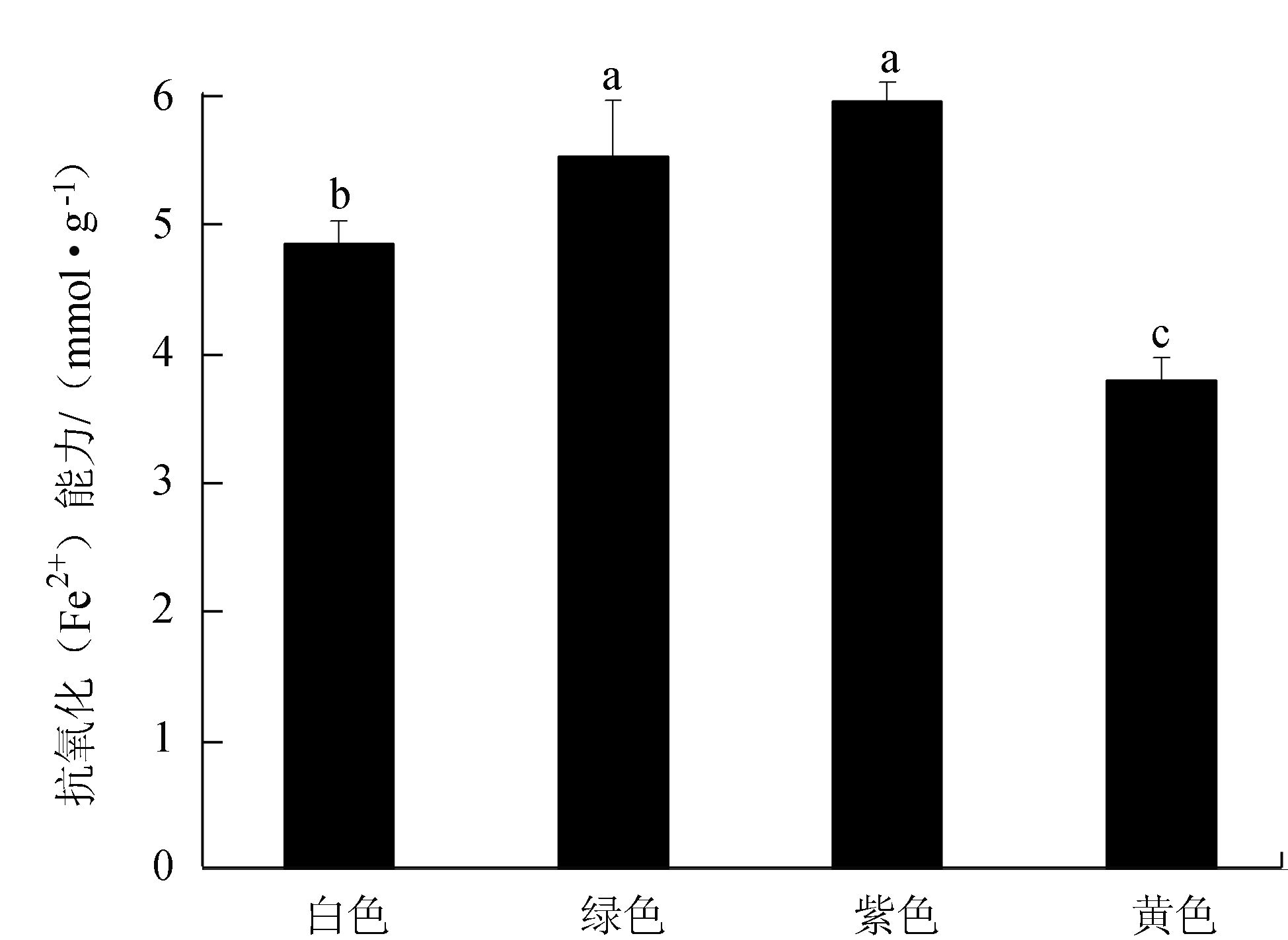Bioactive Substances and Antioxidant Activity in Different-colored Sprouts of Cauliflower (Brassica oleracea var. botrytis L.)
-
摘要: 研究分析不同颜色花椰菜芽菜中芥子油苷等主要生物活性物质及其抗氧化能力。结果表明,不同颜色花椰菜芽菜中芥子油苷的组分和含量差异显著,白色、紫色和黄色花椰菜芽菜中主要芥子油苷为3-甲基硫氧丙基芥子油苷,绿色花椰菜芽菜中主要芥子油苷为4-甲基硫丁基芥子油苷。在芥子油苷含量上,紫色和绿色花椰菜芽菜中的芥子油苷含量最高,白色花椰菜芽菜次之,黄色花椰菜芽菜最少。在测定的4种颜色的花椰菜中,多酚和抗坏血酸的含量也存在差异,白色、绿色和紫色花椰菜芽菜中多酚含量相差不大,黄色花椰菜芽菜最低。抗坏血酸含量则是黄色花椰菜芽菜最高,绿色的最少,其余居中。不同颜色花椰菜的抗氧化能力强弱是多种活性物质共同作用的结果,其中以紫色花椰菜和绿色花椰菜芽菜抗氧化能力较强,白色花椰菜次之,黄色花椰菜最弱。Abstract: Contents of glucosinolate, ascorbic acid and polyphenols, as well as antioxidant activities of 4 cauliflowers (Brassica oleracea var. botrytis L.) that bore sprouts of different colors were studied. The results showed that the compositions and contents of glucosinolate differed in the sprouts. For the white, purple, and yellow sprouts, glucoiberin was most abundant; while for the green sprouts, glucoerucin. The greatest total glucosinolate was found in the purple and green sprouts, followed by the white and yellow. No significant differences on polyphenols were observed among the white, green, and purple sprouts, and yellow sprouts had the least amount of polyphenols. The yellow sprouts contained the highest content of ascorbic acid, followed by the purple and white, and the green sprouts the least. The antioxidant activities in the different-colored cauliflower sprouts were higher in the purple or green than the white or yellow, which was the same for glucosinolate content.
-
Key words:
- cauliflower /
- sprouts /
- glucosinolate /
- different color /
- antioxidant activity
-
表 1 不同颜色花椰菜芽菜中芥子油苷组分和含量
Table 1. Composition and content of glucosinolate in different-colored cauliflower sprouts
[单位/(μmol·g-1FW)] 芥子油苷 不同颜色花椰菜 白色 绿色 紫色 黄色 3-甲基硫氧丙基芥子油苷 1.16±0.28 b 0.22±0.17 c 2.00±0.36 a 0.05±0.01 d 2-羟基-3-丁烯基芥子油苷 0.06±0.01 a 0.02±0.00 b 0.03±0.01 b 0.02±0.01 b 烯丙基芥子油苷 0.05±0.01 a 0.01±0.00 b 0.03±0.02 ab 0.02±0.01 b 3-丁烯基芥子油苷 0.40±0.09 b 0.65±0.20 a 0.66±0.20 a 0.21±0.06 c 4-甲基硫丁基芥子油苷 0.02±0.01 c 1.45±0.32 a 0.22±0.08 b 0.01±0.00 c 脂肪类芥子油苷 1.69±0.33 b 2.34±0.43 ab 2.95±0.33 a 0.31±0.07 c 4-羟基-吲哚-3-甲基芥子油苷 0.03±0.01 b 0.05±0.01 ab 0.07±0.01 a 0.02±0.01 b 吲哚-3-甲基芥子油苷 0.14±0.04 c 0.48±0.04 a 0.35±0.03 b 0.14±0.02 c 4-甲氧基-吲哚-3-甲基芥子油苷 0.21±0.03 ab 0.34±0.04 a 0.27±0.03 a 0.15±0.03 b 1-甲氧基-吲哚-3-甲基芥子油苷 0.05±0.01 a 0.04±0.01 ab 0.03±0.01 bc 0.01±0.00 c 吲哚类芥子油苷 0.43±0.09 b 0.91±0.08 a 0.72±0.09 a 0.32±0.09 b 总芥子油苷 2.13±0.31 b 3.26±0.37 a 3.66±0.49 a 0.63±0.16 c 注:同行数据后不同小写字母表示差异达显著(P<0.05)水平。 -
[1] HIGDON JV, DELAGE B, WILLIAMS D E, et al. Cruciferous vegetables and human cancer risk:epidemiologic evidence and mechanistic basis[J]. Pharmacol Rev,2007,55:224-236. http://cn.bing.com/academic/profile?id=0ec2987ce58b6cf685fa40f563c326dc&encoded=0&v=paper_preview&mkt=zh-cn [2] RAZIS A F A, BAGATTA M, DE NICOLA G R, et al. Up-regulation of cytochrome P450 and phase II enzyme systems in rat precision-cut rat lung slices by the intact glucosinolates, glucoraphanin and glucoerucin[J]. Lung Cancer,2011,71:298-305. doi: 10.1016/j.lungcan.2010.06.015 [3] MANCHALI S, MURTHY K N C, PATIL B S. Crucial facts about health benefits of popular cruciferous vegetables[J]. J Funct Foods,2012,(4):94-106. http://cn.bing.com/academic/profile?id=bd3921a646be4d8a4c7f02a4fb19d80b&encoded=0&v=paper_preview&mkt=zh-cn [4] PRESTERA T, ZHANG Y, SPENCER S R, et al. The electrophile counterattack response:protection against neoplasia and toxicity[J]. Adv Enzyme Regul,1993,33,281-296. doi: 10.1016/0065-2571(93)90024-8 [5] VIG A P, RAMPAL G, THIND T S, et al. Bio-protective effects of glucosinolates-A review[J]. LWT-Food Sci Technol,2009,42:1561-1572. doi: 10.1016/j.lwt.2009.05.023 [6] HALKIER B A, GERSHENZON J. Biology and biochemistry of glucosinolates[J]. Annu Rev Plant Biol,2006,57:303-333. doi: 10.1146/annurev.arplant.57.032905.105228 [7] CISKA E, DRABIИSKA N, HONKE J, et al. Boiled Brussels sprouts:A rich source of glucosinolates and the corresponding nitriles[J]. J Funct Foods,2015,19:91-99. doi: 10.1016/j.jff.2015.09.008 [8] VALE A, SANTOS J, BRITO N, et al. Evaluating the impact of sprouting conditions on the glucosinolate content of Brassica oleracea sprouts[J]. Phytochemistry,2015,115:252-260. doi: 10.1016/j.phytochem.2015.02.004 [9] ÁVILA FW, YANG Y, FAQUIN V, et al. Impact of selenium supply on Se-methylselenocysteine and glucosinolate accumulation in selenium-biofortified Brassica sprouts[J]. Food Chem,2014,165:578-586. [10] TIAN Q, ROSSELOT RA, SCHWARTZ S J. Quantitative determination of intact glucosinolates in broccoli, broccoli sprouts, Brussels sprouts, and cauliflower by high-performance liquid chromatography-electrospray ionization-tandem mass spectrometry[J]. Anal Biochem,2005,343:93-99. doi: 10.1016/j.ab.2005.04.045 [11] PODSÉDEK A. Natural antioxidants and antioxidant capacity of Brassica vegetables:a review[J]. LWT, 2007, 40:1-11. doi: 10.1016/j.lwt.2005.07.023 [12] VOLDEN J, BENGTSSON G B, WICKLUND T. Glucosinolates, L-ascorbic acid, total phenols, anthocyanins, antioxidant capacities and colour in cauliflower (Brassica oleracea L. ssp. botrytis); effects of long-term freezer storage[J]. Food Chem,2009,112:967-976. doi: 10.1016/j.foodchem.2008.07.018 [13] CHIU L W, ZHOU X, BURKE S, et al. The purple cauliflower arises from activation of a MYB transcription factor[J]. Plant Physiol,2010,154:1470-1480. doi: 10.1104/pp.110.164160 [14] 关文强,张怡,刘莉莉,等. 不同颜色菜花生长过程中抗氧化活性与成分的变化研究[J]. 华北农学报,2013,28(6):186-191. http://www.cnki.com.cn/Article/CJFDTOTAL-HBNB201306035.htm [15] 刘维侠,曹振木,廖易. 不同彩色甜椒果实发育过程中色素和抗氧化物质含量的变化[J].热带作物学报,2010,31(12):2187-2192. http://www.cnki.com.cn/Article/CJFDTOTAL-RDZX201012018.htm [16] GUO R, YUAN G, WANG Q. Effect of sucrose and mannitol on the accumulation of health-promoting compounds and the activity of metabolic enzymes in broccoli sprouts[J]. Sci Hortic,2011,128:159-165. doi: 10.1016/j.scienta.2011.01.014 [17] BENZIE I F, STRAIN J. The ferric reducing ability of plasma (FRAP) as a measure of "antioxidant power":the FRAP assay[J]. Anal Biochem,1996,239:70-76. doi: 10.1006/abio.1996.0292 [18] BELLOSTAS N, KACHLICKI P, SØRENSEN J C, et al. Glucosinolate profiling of seeds and sprouts of B. oleracea varieties used for food[J]. Sci Hortic,2007,114:234-242. doi: 10.1016/j.scienta.2007.06.015 [19] SONES K, HEANEY RK, ROGER FENWICK G. Glucosinolates in Brassica vegetables. Analysis of twenty-seven cauliflower cultivars (Brassica oleracea L. var. botrytis subvar. cauliflora DC)[J]. J Sci Food Agric,1984,35:762-766. doi: 10.1002/(ISSN)1097-0010 [20] HOLST B, WILLIAMSON G.A critical review of the bioavailability of glucosinolates and related compounds[J]. Nat Prod Rep,2004,21:425-447. doi: 10.1039/b204039p [21] PLUMB G W, LAMBERT N, CHAMBERS S J, et al. Are whole extracts and purified glucosinolates from cruciferous vegetables antioxidants[J]. Free Radic Res,1996,25:75-86. doi: 10.3109/10715769609145657 [22] BARILLARI J, CANISTRO D, PAOLINI M, et al. Direct antioxidant activity of purified glucoerucin, the dietary secondary metabolite contained in rocket (Eruca sativa Mill.) seeds and sprouts[J]. J Agric Food Chem,2005,53:2475-2482. doi: 10.1021/jf047945a [23] CABELLO-HURTADO F, GICQUEL M, ESNAULT M A. Evaluation of the antioxidant potential of cauliflower (Brassica oleracea) from a glucosinolate content perspective[J]. Food Chem,2012,132:1003-1009. doi: 10.1016/j.foodchem.2011.11.086 -








 下载:
下载:




